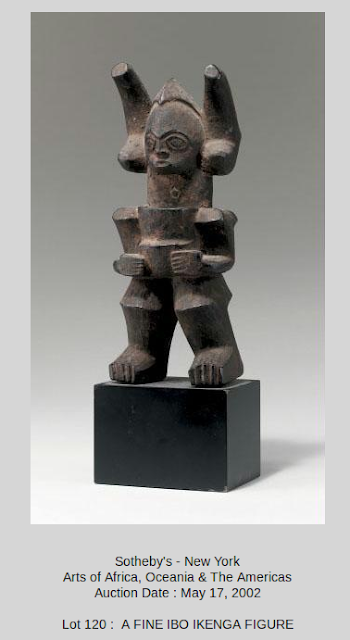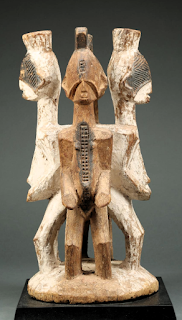Things
coming together, modern and old, tribal art, Ikenga’s, and
Maidenmasks the Igbo from Nigeria. Concept by
Madrason
He
told me he was almost stoned and beaten to death, for his wife
accused him not to have given her children, therefore he was not a man!
After many years of mediation they casted him out!
There
in the mud, face down, he was left for dead. The Igbo elders had
spoken, he could not be changed (for in fact he was a homosexual, and
this is a non-existant in Igbo country) a local CEO from an **
company found and helped him getting back on his feet again. Now here
in the Netherlands I was trying to guide him -for the Dutch Refugee
council- during his application for asylum, through his asylum
procedure.
Igbo Statuette looking like the Okonkwo on the etching of Bruce Onobrakpeya
When
I acquainted myself to him and explained what my aim was, for aiding
him that day and if he would agree. He agreed. He started to slowly
tell me, bit by bit, about his past in Nigeria. I asked him, “do
you know Chinua Achebe” and he replied proudly, “Things falling
apart!” Now I am reading Arrow of God. What struck him was not an
arrow from God, maybe the CEO guy who helped him flee and nursed him
back to health was the arrow. I was in a position to be able to be of
some help that day, for this special person. This is my job and I am
greatful for that. My hobby is writing for positive awareness,
statements on blogs and poetry too. Collecting ethnographic art is
the other one. That very same day that I had spoken with this Igbo
man, I found an etching, of which many months later, I only became to
realize, was the hero Okonkwo himself, sketched by -the inventor of
this alufoiletching techninique- professor Onobrakpeya . This
professor knew Chinua personaly, they where artisian friends and the
leading artsits top of the West coast of Africa, esp. Nigeria.
Only
later I took the etching under the magnifying glass and read to
discover, “Okonkwo”, the professors name and the number of the
etching. What struck me was that I had already acquired an Igbo
statue from past collections of the Museum for Africa, Berg &Dal.
This face and the face of the Okonkwo etching seemed to be twins. I
guess that the professor - like Chinua- took his culture highly serious and
tried to teach-promote about the cultural identity of the Igbo by
incorparating it into writing and into modern art!
The
face of the statue was that of an ancestor, only it was a monkey like
face, more or less baboon alike. And the hairdo was the simalar like
the one portrayed and carved on Igbo Maiden masks, with on to rotan
woven hair into the forms of arches, three to two in climbing rows on
top of their heads vertically.Wow, from Okonkwo the wrestler -and to
become a leader of some Igbo tribal area- to the ethnographic art and
rite, the Netherlands and Igbo-Nigeria, past and present fusing. And
the place and time, an Igbo refugee, me and my poetry and my sense for
tribal art, and the statuette and the etching? Could this be a
coincidence?
I
decided that in line of Chinua, right here in place and time; things
came together after they fell apart! M
Passion
is cosmic and nothing can stop it’s kernel, it helps to become
universal, a homo universalensis. M
Homo
universalensis
I do
not look at thee
as
if upon a honeybee
afraid
if thy might sting
but
rather as a cherrytree
that
blossoms in the spring
you
are not man nor woman
but
of them all first human
a
flower to be admired
a
light desiring to be fired
your
heart is beating at my door
in
room 3, four or five
you
jumped into my life
and
pumped your virtues through
a
Golden Bough to do
it
is my deepest plight
here
on my knees I might
bow
seven times for
je
t'aime and je t'adore
you
and you, yes you.........
Madrason
15-04-2009
The
ones with amassed good chi could become the returners. The alusi
spirits, communicated with folk and this mainly through priests and
or Ikenga housaltars/shrines which guided the Igbo in everyday life’s
decisions. The maiden masks with the crested tripartite hairdo’s
were a sign of prowess and also to appease their ancestral spirits.
Though worn by men, while representing the uttermost feminine Igbo
esthetics, they were regarded as the upper power, esteem and beauty
of women, to honour their strength -scarification tattoos-, their
beauty ;elaborate decoration and care in balanced design and the well
chosen colours applied.
The
statuette holding the hands outwards, seems to imply, welcoming and
openness, to stand to receive without fear (like Okonkwo finally did
with the unavoidable changes, coming from the colonisers) that which
is coming. The face is showing similarity with the maiden Igbomasks.
Here one can see that in fact bodily it is a representation of a
strong man wearing a maiden alike mask! Which is confirming the fact
that men wore these maiden masks in honour of their women and the
tribes’ fertility, strength and fearlessness.
In
the work Okonkwo, professor Onobrakpeya seems to be comprising it all
by telling about this Igbo folklore and ritual story and especially
the story of Chinua in this etching. And the beauty of it all, that
in stead of things to fall apart, to me all things seem to come
together, in true life and trough associated awareness of a universal
moment and that fresh spirit in a refugee with whom I ‘ve had the
honour to get acquainted with . M
Things
Fall Apart Background Information Chinua Achebe is one of the
most well-known contemporary African writers. Things Fall Apart deals
with the clash of cultures and the violent transitions in life and
values brought about by British colonialism in Nigeria in late 1800s.
the novel recounts the life of the village hero Okonkwo and describes
the arrival of white missionaries in Nigeria and its impact on
traditional Igbo society during the late 1800s. Things Fall Apart
includes Western linguistic forms and literary traditions with Igbo
words and phrases, proverbs, fables, tales, and other elements of
African oral and communal storytelling traditions. Slide Show
Igbo
or Ibo society;
The
Igbo people (English: /ˈɪɡboʊ/; erroneously Ibo,[3][4] formerly
also Iboe, Ebo, Eboe,[5] Eboans,[6] Heebo;[7] natively Ṇ́dị́
Ìgbò [ìɡ͡bò] ( listen)[citation needed]) are an
ethnic group native to the present-day south-central and
south-eastern Nigeria. Geographically, the Igbo homeland is divided
into two unequal sections by the Niger River – an eastern (which is
the larger of the two) and a western section.[8][9] The Igbo people
are one of the largest ethnic groups in Africa.[10]
The
Igbo language is divided into numerous regional dialects, and
somewhat mutually intelligible with the larger "Igboid"
cluster.[11] The Igbo homeland straddles the lower Niger River, east
and south of the Edoid and Idomoid groups, and west of the Ibibioid
(Cross River) cluster.
In
rural Nigeria, Igbo people work mostly as craftsmen, farmers and
traders. The most important crop is the yam.[12] Other staple crops
include cassava and taro.[13] The Igbos are also highly urbanized,
with some of the largest metropolitan areas, cities and towns in
Igboland being Onitsha, Enugu, Aba, Owerri, Orlu, Okigwe, Asaba,
Awka, Nsukka, Nnewi, Umuahia, Abakaliki, Afikpo, Agbor and Arochukwu.
Before
British colonial rule in the 20th century, the Igbo were a
politically fragmented group, with a number of centralized chiefdoms
such as Nri, Arochukwu, Agbor and Onitsha.[14] Frederick Lugard
introduced the Eze system of "Warrant Chiefs".[15]
Unaffected by the Islamic jihad sweeping Nigeria in the 19th century,
they became overwhelmingly Christian under colonization. In the wake
of decolonisation, the Igbo developed a strong sense of ethnic
identity.[13] During the Nigerian Civil War of 1967–1970 the Igbo
territories seceded as the short-lived Republic of Biafra.[16]
MASSOB, a sectarian organization formed in 1999, continues a
non-violent struggle for an independent Igbo state.[17]
Small
ethnic Igbo populations are found in Cameroon[18] and Equatorial
Guinea,[19] as well as outside Africa.
Ikenga;
Ikenga (Igbo literal meaning "place of strength") is a
horned Alusi (deity) found among the Igbo people in south-eastern
Nigeria. It is one of the most powerful symbols of the Igbo people
and the most common cultural artifact. Ikenga is mostly maintained,
kept or owned by men and occasionally by women of high reputation and
integrity in the society. It comprises someone's Chi (personal god),
his Ndichie (ancestors), aka Ikenga (right hand), ike (power) as well
as spiritual activation through prayer and sacrifice.[1]
Ikenga
is specially found among the Northern Igbos of Anambra, Enugu, Delta
and some parts of Kogi State.
It
is exclusively an Igbo symbol. Nevertheless, various peoples of
Southern Nigeria have slightly different notions of the components of
an individual personality, but all agree that these various aspects
can only be affected through ritual and personal effort. Some
variants of it are found in Ijaw, Ishan, Isoko, Urhobo and Edo areas.
Among the Isoko people, there are three types of personal shrine
images: Oma, which represents the "spirit double" that
resides in the other world; Obo which symbolizes the right hand and
personal endeavor and the lvri which stands for personal
determination. In the Urhobo areas it is also regarded as Ivri and in
the Edo areas it's called Ikegobo.
Bruce Obomeyoma Onobrakpeya (born
30 August 1932) is a Nigerian
printmaker, painter and sculptor. He has exhibited at the Tate
Modern
in London, the National
Museum of African Art
of the Smithsonian
Institution
in Washington, D.C. and the Malmö
Konsthall
in Malmö,
Sweden.[2]
The National
Gallery of Modern Art, Lagos
has an exhibit of colourful abstract canvases by Onobrakpeya[3]
and his works can be found at the Virtual
Museum of Modern Nigerian Art,
although no exhitions were showing as of October 2017. wiki
Maiden
masks, representations of
adolescent females, impersonate Igbo ideals of youthful feminine
beauty. In their original context, they were danced by male
performers during festivals honoring important patron deities, as
well as for entertainment. During performances, they were
complemented by vibrantly colored suits and accompanied by a
multi-instrumental orchestra. Such dynamic display strongly contrasts
with their static presentation in Western collections. The Met
chinua achebe een wereld val uiteen
maiden mask igbo
igbo hairdo
igbo country
maidenmask
small ikenga
small igbo maiden mask coll M
etching face okonkwo
ikenga
ikenga's
bookcover on igbo arts
ikenga large with maiden mask The Met
harwood ikenga coll M
softwood ikenga with pigment traces on victorian prayer chair coll M
Ikenga on a beaded Victorian prayer-chair, nice patina and colour-pigmentation
urhobo ikenga
kunst$kontext magazine
igbo maidenmask
igbo statuette Okonkwo?
Bruce onobapeya
signed Okonkwo
signature from Bruce
small pigmented igbo statuette
Ibo statuette, background is an old Tekke rug
about Bruce
Urhobo modern large ikenga coll M
cover Things fall apart
bio Bruce Onobrakpeya
Ikenga, Igbo Peoples, Nigeria, wood (University of Pennsylvania Museum of Archaeology and Anthropology) Speakers: Dr. Peri Klemm and Dr. Steven Zucker. Created by Beth Harris, Steven Zucker











































